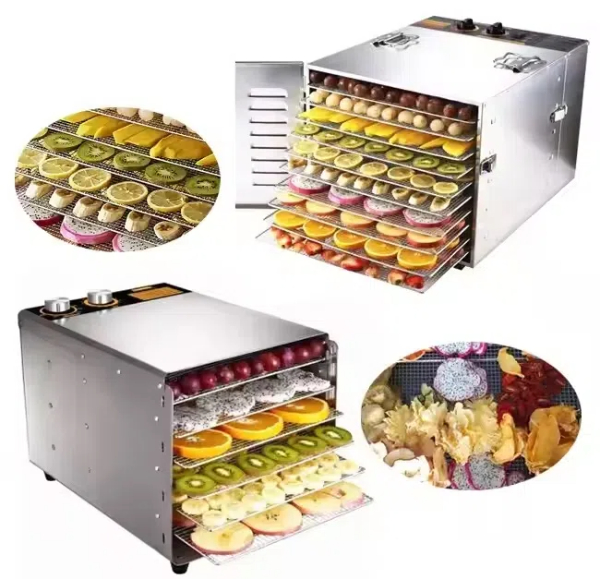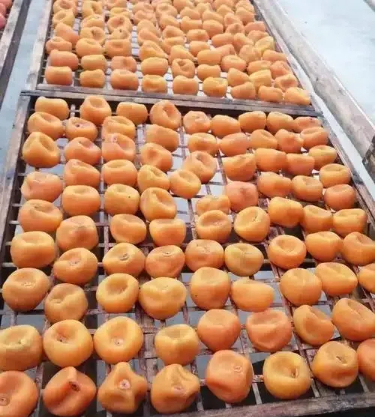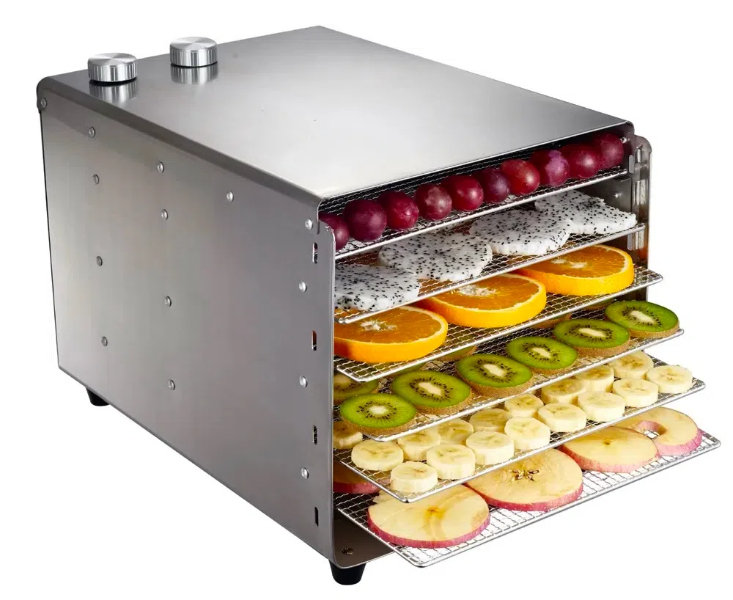
Content Menu
● What is a Cabinet Type Dehydrator?
● Benefits of Using a Cabinet Type Dehydrator
● The Dehydration Process: A Closer Look
● Specific Food Applications: Examples and Recommendations
● Choosing the Right Cabinet Type Dehydrator
● Practical Tips for Using a Cabinet Type Dehydrator
● Conclusion
● FAQ
>> 1. What types of food can be dried in a cabinet dehydrator?
>> 2. How do I clean a cabinet dehydrator?
>> 3. What is the ideal temperature for dehydrating different types of food?
>> 4. How long does it take to dehydrate food in a cabinet dehydrator?
>> 5. Are cabinet dehydrators energy-efficient?
● Citations:
As a Chinese food dehydrator manufacturing factory providing OEM services, it's crucial to understand the advantages of different types of dehydrators. Among these, cabinet type dehydrators stand out due to their efficiency, capacity, and versatility. This article explores the benefits of using a cabinet type dehydrator, highlighting why they are an excellent choice for both commercial and industrial applications.

What is a Cabinet Type Dehydrator?
A cabinet type dehydrator, also known as a shelf style dehydrator, is a large, enclosed appliance with multiple shelves or trays inside. These dehydrators use a heating element and a fan to circulate warm air evenly throughout the cabinet, removing moisture from food items placed on the shelves. Unlike smaller, stackable dehydrators, cabinet models offer greater capacity and control, making them ideal for large-scale food processing. They are designed for continuous operation, often incorporating robust components to withstand the demands of commercial use.
Benefits of Using a Cabinet Type Dehydrator
1. Large Capacity and Space-Saving Solutions: Cabinet dehydrators can hold numerous trays, allowing you to dehydrate large batches of food simultaneously. Their vertical design maximizes the use of floor space, making them suitable for facilities with limited room. Imagine a scenario where a small business owner wants to produce dried fruit snacks for local markets. A cabinet dehydrator allows them to process a significant amount of fruit at once, drastically reducing production time and increasing overall efficiency.
2. Precise Temperature Control: Cabinet dehydrators typically come with sophisticated temperature control systems that allow you to set and maintain the ideal temperature for different types of food. This ensures that the food is dried evenly and thoroughly without overheating or scorching. For example, herbs like basil and rosemary require lower temperatures (around 95-105°F) to preserve their volatile oils and flavors, while meats need higher temperatures (155-165°F) to ensure they are safe to consume. The ability to fine-tune the temperature is crucial for maintaining the nutritional value and sensory qualities of the dried product.
3. Versatility in Food Processing: Cabinet dehydrators can be used to dehydrate a wide variety of foods, from fruits and vegetables to meats and herbs. This versatility makes them a valuable asset for businesses looking to diversify their product offerings. Think about a restaurant that wants to offer homemade dried tomato slices as a unique ingredient in their dishes. A cabinet dehydrator would enable them to produce these in-house, controlling the quality and flavor profile to perfectly complement their menu.
4. Energy Efficiency: Modern cabinet dehydrators are designed with energy efficiency in mind. They often feature insulated walls and doors to minimize heat loss, as well as efficient heating and cooling components. Some models also come with advanced control systems that optimize energy consumption based on the moisture content of the food. This is particularly important for businesses looking to reduce their operating costs and minimize their environmental impact.
5. Reduction of Food Waste: Cabinet dehydrators can help address the issue of food waste by preserving excess food that would otherwise spoil. By dehydrating fruits, vegetables, and meats before they go bad, you can extend their shelf life and reduce the amount of food that ends up in the trash. This not only benefits the environment but also improves the bottom line for businesses by reducing waste-related expenses.
6. Enhanced Food Safety: Cabinet dehydrators help ensure food safety by removing moisture, which inhibits the growth of bacteria, mold, and other microorganisms. The precise temperature control and uniform drying capabilities of these dehydrators further minimize the risk of contamination. Proper food handling practices, combined with the use of a cabinet dehydrator, create a safe and reliable food processing environment.
7. Extended Shelf Life: One of the most significant benefits of using a cabinet dehydrator is the extended shelf life it provides for food products. Dehydrated foods can last for months or even years without spoiling, making them ideal for long-term storage and distribution. This allows businesses to expand their market reach and offer products that can be enjoyed year-round, regardless of seasonal availability.
8. Easy to Use and Maintain: Cabinet dehydrators are designed to be user-friendly, with simple controls and easy-to-clean components. Many models come with removable trays and stainless-steel interiors, making them easy to sanitize. This reduces labor costs and ensures that the dehydrator can be maintained in optimal condition for years to come.
9. Prep for Emergencies: Dehydrating food for emergencies is also a great solution. Having dehydrated food on hand will ensure that you and your family have enough to eat in case of an emergency. Imagine a scenario where a natural disaster disrupts food supplies. Having a stock of dehydrated fruits, vegetables, and meats can provide essential nutrients and calories until normal supply chains are restored.
The Dehydration Process: A Closer Look
Understanding the dehydration process is critical to maximizing the benefits of a cabinet type dehydrator. The goal is to remove enough moisture from the food to prevent microbial growth and enzymatic activity, while preserving its flavor, texture, and nutritional value.
1. Preparation: The first step is to prepare the food for dehydration. This typically involves washing, peeling, slicing, and/or dicing the food into uniform pieces. The size and shape of the pieces will affect the drying time, so it's important to ensure consistency.
2. Pre-treatment: Some foods may require pre-treatment to prevent discoloration or enhance flavor. For example, fruits like apples, bananas, and peaches tend to brown during dehydration due to enzymatic oxidation. Dipping them in a solution of lemon juice or ascorbic acid (vitamin C) can prevent this. Vegetables like green beans and broccoli can be blanched (briefly boiled) to stop enzymatic activity and preserve their color.
3. Loading the Dehydrator: Arrange the food pieces in a single layer on the dehydrator trays, leaving space for air circulation. Avoid overcrowding the trays, as this can impede airflow and result in uneven drying.
4. Setting the Temperature and Time: Consult a reliable dehydration guide or recipe for the recommended temperature and time settings for the specific food you are dehydrating. The optimal temperature will vary depending on the type of food, its moisture content, and the desired outcome.
5. Monitoring the Drying Process: Check the food regularly during the dehydration process to monitor its moisture content and adjust the temperature or time as needed. The food should be dry but not brittle. It should be pliable and leathery, with no visible signs of moisture.
6. Cooling and Storage: Once the food is dehydrated, allow it to cool completely before storing it in airtight containers. This prevents condensation from forming, which can lead to mold growth. Store the containers in a cool, dark, and dry place to maintain the quality and extend the shelf life of the dehydrated food.

Specific Food Applications: Examples and Recommendations
- Fruits: Apples, bananas, berries, grapes, mangoes, peaches, pears, and plums can all be successfully dehydrated in a cabinet dehydrator. They can be enjoyed as healthy snacks, added to granola or trail mix, or used in baking. Consider sprinkling cinnamon or other spices on the fruit before dehydrating to add flavor.
- Vegetables: Carrots, celery, corn, green beans, mushrooms, onions, peppers, potatoes, spinach, and tomatoes can be dehydrated and used in soups, stews, casseroles, and stir-fries. Dehydrated vegetables can also be ground into a powder and used as a seasoning.
- Meats: Beef jerky, chicken jerky, and other dried meats can be made in a cabinet dehydrator. Use lean cuts of meat and marinate them in a flavorful sauce before dehydrating. Ensure that the meat is heated to a safe internal temperature (160°F for beef, 165°F for poultry) before, during, or after dehydration to kill any harmful bacteria.
- Herbs: Basil, chives, dill, mint, oregano, parsley, rosemary, and thyme can be dried in a cabinet dehydrator and used to flavor dishes. Dry the herbs at a low temperature to preserve their volatile oils and aromas.
Choosing the Right Cabinet Type Dehydrator
Selecting the appropriate cabinet type dehydrator is vital to maximizing your food processing operations, but what should you be looking for?
1. Capacity: Determine the amount of food you need to dehydrate on a regular basis and choose a dehydrator with enough trays to accommodate your needs.
2. Temperature Control: Look for a dehydrator with precise temperature control and a wide temperature range to accommodate different types of food.
3. Airflow: Ensure that the dehydrator has a powerful fan and a well-designed airflow system to ensure even drying.
4. Materials: Choose a dehydrator made from durable, food-grade materials like stainless steel.
5. Ease of Cleaning: Select a dehydrator with removable trays and easy-to-clean components.
6. Energy Efficiency: Look for a dehydrator with insulated walls and doors to minimize heat loss.
7. Warranty and Support: Choose a dehydrator from a reputable manufacturer with a good warranty and customer support.
Practical Tips for Using a Cabinet Type Dehydrator
- Pre-treat foods: Some fruits and vegetables benefit from pre-treatment to prevent discoloration or enhance flavor. For example, apples can be dipped in lemon juice to prevent browning.
- Arrange food in a single layer: To ensure even drying, arrange food pieces in a single layer on the dehydrator trays, leaving space for air circulation.
- Monitor moisture content: Check the moisture content of the food regularly during the dehydration process. Food should be dry but not brittle.
- Store properly: Once the food is dehydrated, store it in airtight containers in a cool, dark place to maintain its quality and extend its shelf life.
Conclusion
Cabinet type dehydrators offer a range of benefits for both commercial and home use. Their large capacity, precise temperature control, and energy efficiency make them an excellent choice for preserving food, reducing waste, and creating healthy snacks. Whether you are a food processing business or a home cook, a cabinet dehydrator can help you make the most of your ingredients and enjoy delicious, shelf-stable foods year-round.

FAQ
1. What types of food can be dried in a cabinet dehydrator?
Cabinet dehydrators can dry a wide variety of foods, including fruits, vegetables, meats, herbs, and even flowers. The precise temperature control allows you to customize the drying process for different types of food.
2. How do I clean a cabinet dehydrator?
Most cabinet dehydrators have removable trays and stainless-steel interiors, making them easy to clean. Simply wash the trays with soap and water, and wipe down the interior of the dehydrator with a damp cloth.
3. What is the ideal temperature for dehydrating different types of food?
The ideal temperature for dehydrating food depends on the type of food and its moisture content. In general, fruits and vegetables should be dehydrated at a lower temperature (130-140°F), while meats should be dehydrated at a higher temperature (155-165°F).
4. How long does it take to dehydrate food in a cabinet dehydrator?
The amount of time it takes to dehydrate food in a cabinet dehydrator depends on the type of food, its thickness, and the temperature. In general, it can take anywhere from 4 to 24 hours to dehydrate food completely.
5. Are cabinet dehydrators energy-efficient?
Modern cabinet dehydrators are designed with energy efficiency in mind. They often feature insulated walls and doors to minimize heat loss, as well as efficient heating and cooling components.
Citations:
[1] https://www.dryeratech.com/top-10-benefits-of-using-a-cabinet-type-dehydrator.html
[2] https://patents.google.com/patent/CN110207480A/zh
[3] https://www.dryeratech.com/advantages-of-using-a-cabinet-type-dehydrator-for-food-preservation.html
[4] https://patents.google.com/patent/CN201919616U/zh
[5] https://dehydratorfactory.com/dehydrator-equipment/Cabinet-dryer.html
[6] https://patents.google.com/patent/CN1110593C/zh
[7] https://aradmachineryco.com/catproduct/Cabinet-dryer











